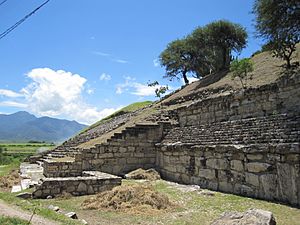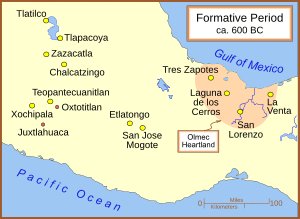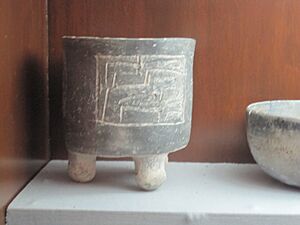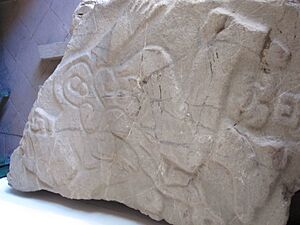San José Mogote facts for kids
San José Mogote is an ancient archaeological site in Mexico. It was a very important city for the Zapotec civilization, a culture that lived in the area now known as Oaxaca. Before the famous city of Monte Albán became powerful, San José Mogote was the biggest and most important settlement in the Valley of Oaxaca. This was during the Early and Middle Formative periods, which lasted from about 1500 to 500 BCE.
The site is located in a rich farming area of the Oaxaca Valley. Today, it's surrounded by the village of San José Mogote, about 12 kilometers (7.5 miles) northwest of Oaxaca City.
San José Mogote is thought to be the oldest permanent farming village in the Oaxaca Valley. It was probably the first place in the area to use pottery. This ancient site also has Mexico's oldest known defensive walls and special ceremonial buildings from 1300 BCE. People here used adobe bricks by 850 BCE. They also had the first signs of Zapotec writing (hieroglyphs) around 600 BCE. Early examples of terraced farming, special crafts, and irrigation systems were also found here, dating from 1150-850 BCE.
Archaeologists like Kent Flannery and Joyce Marcus have studied San José Mogote for many years. Their work shows that it was an early center of Zapotec culture. Over time, it was replaced by Monte Albán. San José Mogote started as a few family homes. It grew to include huge public buildings, showing it was a complex political center. It controlled many smaller settlements in the Valley of Oaxaca, receiving goods and services from them. For reasons that are not fully clear, its power decreased. It then became a smaller town under the control of Monte Albán.
Contents
Ancient Settlements in Oaxaca Valley
San José Mogote was in the most developed part of the Valley of Oaxaca. Many smaller settlements supported it. Some of these included San Pablo Huitzo, Santa Marta Etla, Hacienda Blanca, Tomaltepec, Zaachila, Abasolo, Mitla, Tilcajete, Zegache, and Santa Ana Tlapacoyan.
How Civilization Grew in Oaxaca Valley
Between 1500 and 1150 BCE, San José Mogote grew from a few houses to a village covering about 2,000 square meters (five acres). It was the largest of about 25 villages in the Valley of Oaxaca. It was also the only community in the area with public buildings. Two new ways of irrigation might have helped farmers grow more food. These included digging ditches from streams to water crops. Another method was "pot irrigation," where people scooped water from shallow wells to pour on their plants.
The settlement had many different households, which were the basic family groups. A typical home at San José Mogote had cooking tools like braziers, earth ovens, or hearths. They used stone manos and metates for grinding food. They also had blackened pottery. Food, including maize (corn), was stored in bell-shaped pits outside the house walls. Later, trash was thrown into these pits. Burials and other activity areas were also near the houses.
Evidence of special ceremonies includes human and animal figures found with burials. Signs of trade with faraway places include obsidian stone tools. Obsidian is a type of volcanic glass not found in the Oaxaca Valley.
After 1150 BCE, other settlements stayed small. But San José Mogote's population grew, and its public buildings became more impressive. This showed its role as the main city controlling other villages. Between 900 and 600 BCE, the valley's population tripled to 2,000 people in 40 communities. Half of these people lived in San José Mogote, which grew to 50 acres in size.
A community building, sometimes called a "men's home," was likely a place for men to meet for community and religious events. This building was important for ceremonies. It was built facing eight degrees west of north. La Venta, an important Olmec site, has the same direction. This suggests they understood astronomy and had a calendar system.
Only at San José Mogote were mirrors made from polished magnetite. These mirrors were traded to the Olmec Gulf Coast, about 400 kilometers (250 miles) away. More obsidian and ceremonial items also suggest trade. These items included drums made from turtle shells, conch-shell trumpets, and stingray spines. Pottery designs linked to Olmec groups were also found, especially at San José Mogote.
By 700 BCE, San José Mogote's population kept growing. Between 700 and 500 BCE, 3,500 people lived in the Valley of Oaxaca. About 1,000 of them lived in San José Mogote, which covered about 60 hectares (150 acres). Large public buildings were made with adobe bricks and big stone blocks. These were built on top of dirt mounds. The biggest complex before 500 BCE was Mound 1 at San José Mogote. It was built on a hill that was made taller, reaching 15 meters (49 feet) high.
How Leaders Emerged
In a short time, the Zapotec civilization in this area changed. It went from a community where everyone was equal to a society with different social levels. This was a big moment in history, seen in many other ancient Mesoamerican sites like Paso de la Amada and San Lorenzo Tenochtitlán.
Experts believe that by the end of the San Jose Phase, San José Mogote was clearly a "chiefdom." This means it was led by a powerful chief. We don't know exactly when or how leaders with inherited power appeared at San José Mogote. But there are clues about how this change happened.
One idea is that a person or group used some kind of power to start controlling others. Stronger groups might have forced weaker ones to follow them. They could have gained power in a few ways:
- Smart Farming: Choosing the best farming spots could give a person or group more crops. This would give them an advantage.
- Good Alliances: Making strong friendships with other groups could protect them from attacks.
- Strong Families: Having many healthy children would ensure their family line stayed powerful for a long time.
Another idea is that someone might have used the idea of "giving back" to gain control. For example, if a farmer had a huge harvest one season, they might host a big feast for the community. By giving food, they might subtly persuade others to help them with labor or goods. This could slowly give the farmer an economic advantage.
It's also thought that a person in these early communities might have claimed to have special spiritual powers. This would help them rise in social rank. If they were the only link to the spirit world, they would become very important. Spirituality was a huge part of ancient Mesoamerica. So, claiming special powers, whether true or not, would greatly increase their social standing.
It's believed that some or all of these factors led to the social differences at San José Mogote. This change likely happened slowly, not overnight.
Once San José Mogote became a chiefdom, it started to control nearby communities. It was supported by smaller villages, like the farming community of Tierras Largas, about 16 kilometers (10 miles) to the southeast. San José Mogote became known as a "capital" or main center for trade and leadership for many surrounding homes.
For San José Mogote to become this powerful leader, its people likely chose a person strong enough to influence and persuade people in local villages to work with them. The size of the buildings and the materials brought in to build them show that San José Mogote's leaders could control people in the surrounding countryside.
Buildings, Size, and Population
San José Mogote had many small homes spread across its 20-hectare (about 50-acre) area. These homes housed around 1,000 people. This was about half the population of the entire Valley of Oaxaca during the San José Phase.
A special meeting hall for men was found within San José Mogote. It was clearly rebuilt many times over the years.
Structures 1 and 2 at San José Mogote together form an impressive, large public building. This was likely a place where people from different groups could come together to discuss important issues.
New Ideas and Art
Iron ore was found in the Valley of Oaxaca. Since San José Mogote was the main trading center, it used its rich iron ore to make polished stone mirrors. Many of these mirrors have been found as far away as the Olmec Gulf Coast.
Two main designs are found on pottery from the Valley of Oaxaca. These represent the forces of earth and sky. Earthquakes symbolize the earth, and lightning symbolizes the sky. Small villages often had pottery with lightning or sky designs. Tierras Largas had pottery that mostly showed earthquake or earth designs. San José Mogote had a mix of both.
Crop production might have increased at San José Mogote because of two simple irrigation methods: Pot irrigation and Irrigation ditches. Pot irrigation involved digging many shallow wells to collect water. This water was then scooped up to water nearby plants. Irrigation ditches were small systems used to get water from streams to flow over the plants.
Monument 3
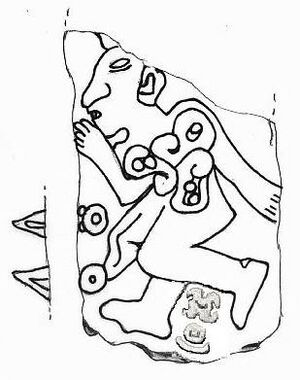
A flat, carved stone, called Monument 3, was placed as a doorstep to a special ceremonial building. This stone shows drops of blood and a possible calendar day-name "1 Earthquake." These are the earliest Zapotec writings known. While stingray spines and similar objects suggest people might have drawn their own blood for rituals, the figure on Monument 3 shows a sacrifice of a person, likely a captive. Later, similar carved figures, called danzantes (dancers), were found at Monte Albán.
Later, the public buildings on Mound 1 were rebuilt to be a home for an important family.
By 500 BCE, Monte Albán became the main city in the area. San José Mogote's 1,000 years of power ended. It became a smaller community under Monte Albán's control.
Some of the ancient objects from San José Mogote can be seen in the San José Mogote Community Museum. It is located in the El Cacique Hacienda.
See also
 In Spanish: San José Mogote para niños
In Spanish: San José Mogote para niños


